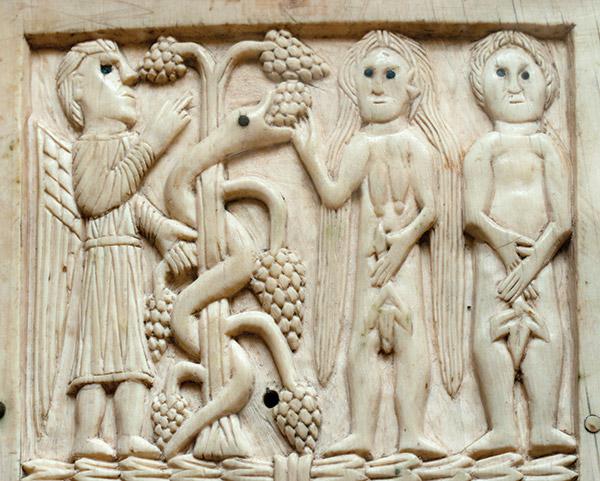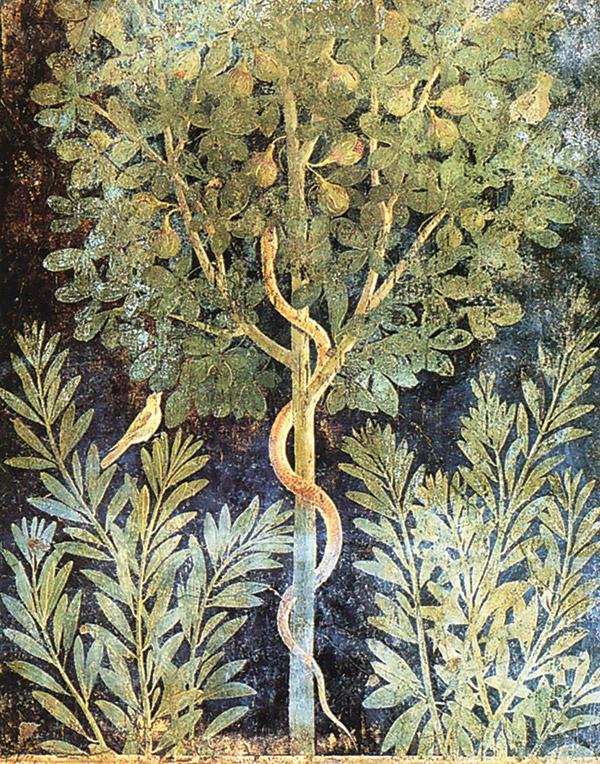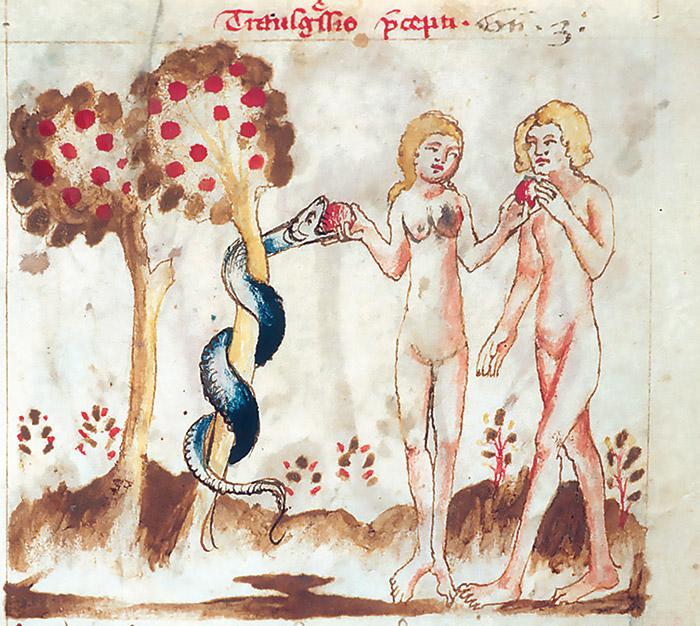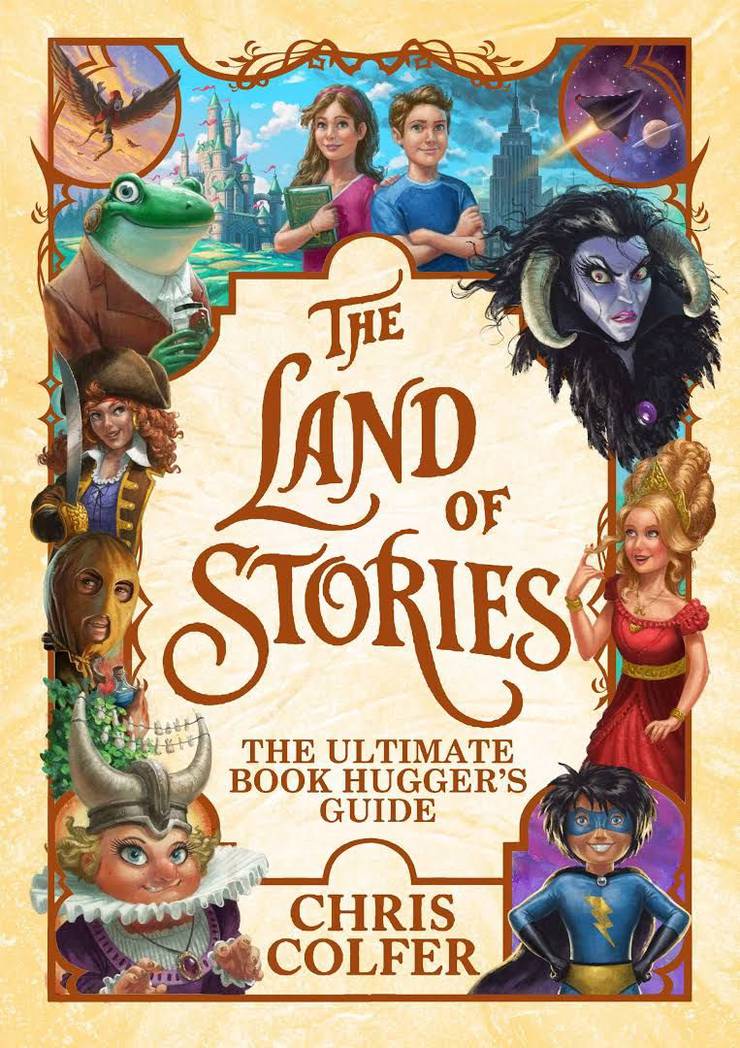Appendix: Book Review Discussing What Fruit Eve Ate
Jewish Review of Books, Fall 2023
Fruit of the Fall
Reviewed By: Philip Getz
By: Azzan Yadin-Israel; University of Chicago Press; 232 pp., $27.50
Back in 1997, a horticulturist at Washington State University named Bruce Barritt placed pollen from a Honeycrisp on the stigma of an Enterprise apple flower. Twenty-two years of testing later the Cosmic Crisp apple was released, to great acclaim. The New York Times described it as “dramatically dark, richly flavored and explosively crisp and juicy,” almost sinfully good, one might say.
This wasn’t the first time apples burst cosmically onto the cultural scene. In twelfth-century France, apples began showing up in Christian depictions of “the Fall of Man,” everywhere from the Cathedral of Notre Dame to illuminated Bibles and psalm books. These red and gold apples supplanted the previous identification of grapes and figs as the forbidden fruit with which the serpent tempted Eve and Eve tempted Adam. Grapes and figs are low-hanging fruit, biblically speaking. The Land of Israel, for instance, is described as “a land of wheat and barley, of vines, figs, and pomegranates, a land of olive trees and honey” (Deut. 8:8)—but not of apples, not here or anywhere else in the Bible. Where did they come from? This is the central question of Azzan Yadin-Israel’s scrumptious scholarly morsel of a book, Temptation Transformed.
As readers of Hebrew will know, the story of Genesis never identifies the actual species of fruit that was forbidden to Adam and Eve in the Garden of Eden, referring to it with the generic peri (fruit). The early Aramaic, Greek, and Latin translations are faithfully generic as well: peirei, karpos, and fructus (and, importantly, as we’ll see later, pomum). The earliest interpretive tradition, dating back to 1 Enoch in the third century BCE, has the forbidden fruit “resembling a cluster of grapes.” 3 Baruch (from the first century CE) and the Apocalypse of Abraham (second century CE) take up this tradition. It is, of course, a plausible association given the grape’s intoxicating powers. The Rabbis were not particularly occupied with identifying the species of fruit in the story, but when they did take up the question, they tended to agree. Rabbi Meir, for instance, said, “That tree from which Adam ate was a vine, for nothing but wine (yayin) brings wailing (yelalah) to man (adam)” (Sanhedrin 70a).

Part of an ivory relief depicting Adam and Eve with grapes, ca. 1000–1099, Hermitage Museum, Saint Petersburg. (Courtesy of Genevra Kornbluth.)
Saint Augustine, who was himself famously tempted by a pear as a boy, nevertheless followed the other dominant ancient interpretation, which identified the forbidden fruit as a fig. This tradition is, if anything, even more textually plausible than that of the grape. Immediately after Adam and Eve ate of the fruit they realized that they were naked “and they sewed fig leaves together and made loincloths for themselves” (Gen. 3:7). This would make sense if they were standing under a fig tree. Christian artists doubled down on the fig tradition, featuring both the fruit and fig leaves prominently in the catacomb frescoes and sarcophagi depicting the sin that introduced mortality. As Yadin-Israel writes, “Fortunately, fig leaves have a distinct morphology—they are wide and consist of three to five distinct lobes—making it easier to identify the Tree of Knowledge.”
In addition to being a philological detective story, Temptation Transformed is a kind of mini- ature coffee-table book, employing forty-two images of Fall of Man art to chart the transformation from grape and fig (and a few other fruits) to apple. (Yadin-Israel has compiled hundreds more—which can be sorted by fruit, region of origin, or medium—on the book’s companion website, treeofknowledgeart.com.) And so we find ourselves accompanying the author on his linguistic-artistic expedition to discover how and why the apple came to represent the forbidden fruit of the Tree of Knowledge of Good and Bad.
Yadin-Israel is not the first to discuss this erroneous identification of the forbidden fruit with the apple. In 1646, Sir Thomas Browne published a book called Pseudodoxia Epidemica: or, Enquiries into Very Many Received Tenets and Commonly Presumed Truths, also known by the simpler title Vulgar Errors, which is what it cataloged. Book 7 concerned biblical misconceptions, first among them being that the fruit of the Tree of Knowledge was an apple. Browne suggested that some authorities had identified that as the forbidden fruit because in Latin the word “malum”means both “bad” and “apple.” As Yadin-Israel puts it:
The logic seems compelling: the forbidden fruit caused the Fall of Man, introducing death into the world—a terrible malum (“evil”) if ever there was one. What fruit, then, would medieval scholars who read and interpreted the Bible in Latin consider better suited to the role than the malum (“apple”)?
This neat explanation was taken up by modern scholars, including the distinguished twentieth-century German Lutheran scholar Gerhard von Rad and, more recently, Ziony Zevit in a widely read book called What Really Happened in the Garden of Eden? Whatever did happen in the Garden of Eden, Yadin-Israel demonstrates that this linguistic misunderstanding never occurred, no matter how plausible it sounds. It turns out that the word “malum”so rarely appears in Latin translations of Genesis that this explanation is certainly false. In fact, the word was specifically avoided precisely because of its malevolent resonance.

Serpent in fig tree. Roman fresco from the Casa del Frutteto, Pompeii. (Wikimedia Commons.)
Yadin-Israel considers several other possibilities as to how the fruit became an apple before learnedly, patiently, refuting them. My favorite of these takedowns is his consideration of the hypothesis that the transformation was inspired by the rejuvenation of apple cultivation in twelfth-century France. Again, it sounds plausible. Quoting Erika Janik’s Apple: A Global History, and crediting the fortunately named Natan Paradise of the University of Minnesota with the suggestion, Yadin-Israel writes, “In twelfth-century Europe, the expansion of the Cistercian order of monks . . . renewed the cultivation of apples across the continent.” Understanding this hypothesis requires understanding at least the basics of apple cultivation. It turns out that every apple is a little like the Cosmic Crisp. As Yadin-Israel deftly summarizes:
Apple trees are self-incompatible, that is, the apple blossoms of one tree require pollination from another apple tree. Left to their own devices, then, new apple trees will not produce the same apples as those that provided their seeds. Farmers can combat this generational inconsistency by grafting a shoot from the parent tree onto the rootstock of the descendant, thus ensuring the offspring will be true to stock. This technique was familiar to Roman farmers, but declined in the early Middle Ages, and with it apple cultivation. Grafting was revived in the twelfth century by the monks of the Cistercian order.
But, as Yadin-Israel demonstrates, the art of apple cultivation was never really as lost as this story suggests. He quotes a Carolingian from the late eighth or early ninth century referring to “various kinds of apple trees, various kinds of pear trees, various kinds of plum trees, sorb, medlar, chestnut and peach, etc.” He further cuts down the Cistercian hypothesis by noting, among other things, that local fruit cultivation does not seem to have particularly influenced previous depictions of the forbidden fruit:
The implied causal connection between local agriculture and iconographic conventions is tenuous at best: though figs and grapes do not grow in cold climates, they figured prominently in the medieval iconography of Germany and Russia, respectively. Conversely, pears were common in France but never associated with the forbidden fruit.

Speculum humanae salvationis, 1375–1399. London, British Library, MS Har-ley 3240, fol. 5r. (Courtesy of the British Library Board, Harley 3240, fol. 5r.)
There may be room to quibble here. As Yadin-Israel has already shown us earlier, figs and grapes are almost natural choices, given their ubiquity in the Bible, the association of grapes and wine with sin, and the place of fig leaves in the story. The entrenched ecclesiastical tradition identifying these fruits with the Fall would, arguably, be enough to keep them in the picture(s) even in lands to which they were not agriculturally suited. Regardless, Yadin-Israel is a master of philological and iconographic detective work, and the joy of this beautiful little book is in following his reasoning as he thinks through words (in a daunting number of languages) and images.
Much as Rashi did in the very time and place in question, Yadin-Israel eventually finds answers in the Old French. The generic word for fruit in Old French, pom, derives from the Latin pomum, which had been the Latin word commonly used to translate the similarly generic Hebrew peri. But in the twelfth century pom began specifically to designate apples. French readers of the Latin then projected this new meaning of pom onto its linguistic ancestor pomum, thereby transforming the generic fruit into their vernacular pom: a tempting apple.
Philip Getz is senior editor for history and religion at Palgrave Macmillan and the former associate editor of the Jewish Review of Books.
https://jewishreviewofbooks.com/philosophy/14750/fruit-of-the-fall/
Eve As the First Parent
My New Mom Friend, Eve
While pregnant with Sylvia, I was in the middle of creating a musical midrash project, interpreting the stories of biblical women through indie rock songs. I’d begun this project in graduate school, and then it took on a life of its own; years later, I was still researching female biblical characters and writing songs in their voices. Sometimes it felt as if the women were speaking through me.
But I had a hard time connecting with Eve.
I loved so many other women from the Hebrew Bible: Sarah and Rachel and Esther and Vashti and Ruth…The list goes on. These characters dealt with family and politics and the question of how honest to be with each other and themselves. They laughed, flirted, fibbed, messed up, triumphed, and took giant risks to stand up for what they believed in. They seemed like people I might hang out with in real life.
Next to them, Eve, the first woman, had always seemed a little vague — too mythic, too abstract, too archetypal.
But as my due date approached, I began to feel a connection to Eve. After all, she’d been pregnant too. It was like when I passed another pregnant lady on the street; I spotted Eve’s belly, and nodded to her with a slight smile of recognition.
In my mind, like all first-time moms, Eve and I were bonded by our shared terror and joy. Was I projecting? Absolutely. But with biblical characters, that’s allowed.
In fact, projecting ourselves into the text is an important part of creating midrash.
Now that we were getting to be friends, I felt it was time to write a song about Eve. So I began to spend hours digging into her story, imagining her excitement, confusion, and fears.
I also realized something poignant about Eve’s story. As the first mother, she was really, truly, on her own.
I may have felt overwhelmed sometimes, but the truth was, I was surrounded by expertise and support, both scientific and empirical. I had my mother and my midwife, along with friends who’d already had kids. I had ultrasounds and the beautiful chirp of my baby’s heartbeat on the Doppler. And thanks to the internet, I had endless (sometimes overwhelming) access to advice, studies, recommendations… the list goes on.
Eve had none of this.
No books, no internet, no videos, no midwife, no mother.
No one had ever been pregnant before; no one had ever given birth.
I thought a lot about the loneliness of Eve’s pregnancy.
After Sylvia was born, I moved on to wondering how early motherhood would have gone for Eve and her babies. I imagined her heart-shattering love for baby Cain — the first baby ever! I imagined her delight as Abel arrived and then as the two boys played together.
Then I thought about that moment years later, when Cain kills Abel in a field. My heart broke. And I sat down with my guitar to write a song for Eve.
As I wrote, I thought about how Eve’s story connects to our own. Though her story is intensely dramatic, like most Torah stories, and written on a mythic scale, it reflects a truth that echoes through every parent’s experience. To assume responsibility for another human being’s life is an impossible task. We are responsible for our children, but we are, ultimately, also helpless.
It’s a terrible conundrum. We parents have both too much power and too little; we are charged with keeping our children safe, yet we are powerless to do so. We are responsible for our children, yet we don’t control them. How can we bear it?
One answer from Jewish tradition is that we are not alone: we are partners with God in the creation and caretaking of our children.
Whether we relate to the concept of God as a divine force, or simply a wild-card metaphor for everything we cannot control about life, this tradition feels precisely right to me. We’re a big part of the picture, but there’s a bigger picture beyond us, too. All we can do is accept responsibility for our part of parenting and let go of the rest.
As our kids will figure out sooner or later, we’re not in control.
I’m grateful to Judaism for this reminder that, in the end, none of use can be wholly responsible for our children. We can only do our best. And I’m grateful to Eve for helping me appreciate another, more tangible source of support: other mothers, both past and present.
Unlike the First Mother, we are lucky to be surrounded by other women who can hold us and walk beside us when it gets rough. The midwives and nurses and doctors who work to keep us safe. The moms at our same stage in the parenting journey, who know what we’re dealing with. The mothers who are a few steps ahead of us and help light the way. And the long line of ancestral mothers who came before us — all the way back to Eve.
“Open the Ground”
By: Alicia Jo Rabins
Open the Ground
a song in Eve’s voice by Alicia Jo Rabins/Girls in Trouble
The raven showed us how to open the ground And feed it what it grew But all the while as we buried your brother I was thinking of you
Where would you wander And would you ever stay And could I have taught you Some other way
The pain was so terrible I thought I was dying I thought that I would split in two But a sound came from me And I opened wide And then, there was you
I didn’t want to tame you I loved you as you were If I’d had a mother Maybe I’d have learned from her
Will some woman love you In that faraway place For the strength in your hands And the mark on your face
Seven times seven How much is it worth? Flaxseed and blood, All the fruit of the earth.
What did you say Out in the field that day And how did he answer you You always were convinced That you were somehow less than him Though I told you it wasn’t true
And who is counted lucky, the living or the dead When sin is always crouching just ahead?
https://jwa.org/teach/girlsintrouble/eve-the-mother
Back to the Sources, edited by Barry Holtz (1984)
”The scene shows the woman’s thoughts: “The woman saw that the tree was good for food, that it was a delight to the eyes,,,, and that the tree was desirable to contemplate [or: desirable for becoming intelligent], and she took of its fruit and she ate, and she gave also to her husband with her, and he ate.” This verse is unique for its complete emphasis on the woman’s perspective in the scene: the serpent has receded completely, as if he had been only a figment of her imagination in the first place, and as if it were the thoughts that now reign in her that lead her to partake of the tree. Moreover, the man is represented as if he had been there all along, a mere appendage to her thoughts and deeds. His thoughts are not presented at all, as if to trivialize his own motivations for joining her in the transgression. Whether it was the tree’s delightful appearance, the taste of its fruit, the serpent’s blandishments, the woman’s coaxing, or simply the man’s passive acquiescence that led to his eating, the result is the same. That the woman here is presented as the active figure will make clearer the nature of her punishment in Gen. 3:16, where she is made subordinate to the man (as women will generally be shown throughout the rest of the Bible, with certain notable exceptions).
- P. 55
The Bible With and Without Jesus, by Amy-Jill Levine and Marc Zvi Brettler (2020)
The Lord God, who cares about this creature, then realizes "It is not good that the man [ha'adam] should be alone; I will make him a helper as his partner" (Hebrew 'ezer kenegdo) (Gen 2:18). The first word, 'ezer, "helper", does not imply subordination; it may be used of an equal or even someone superior. It appears in popular personal names such as Ezra (helper) and Azariah (or its variant, Azaryahu), meaning "the Lord is [my] helper"; it also describes God in Psalm 121:2: "My help ['ezer] comes from the Lord / who made heaven and earth." The second word, neged, means "in front of", "corresponding to", and even "opposite". Thus, this helper should be understood as a partner for ha'adam.
Neither is the role of the helper to provide ha'adam offspring. "Be fruitful and multiply" is the P version of the story, not the J version. Nor would procreation be advisable for immortal beings; the garden would quickly become overpopulated. The concern for overpopulation might seem anachronistic, but the Mesopotamian epic Atrahasis, written centuries earlier than the garden story, mentions the great noise caused by overpopulation and presents mortality as a remedy.
The role of the helper, created as ha'adam's equal, is to alleviate ha'adam's solitary state in Eden.




